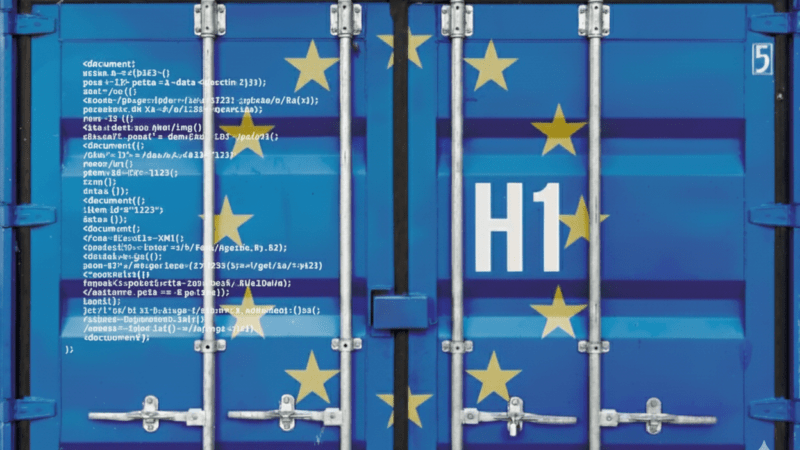 The program will facilitate the development of projects of common interest to create a multimodal, efficient and interconnected network. (GettyImages)
The program will facilitate the development of projects of common interest to create a multimodal, efficient and interconnected network. (GettyImages)
All you need to know about CEF 2: funding to boost the Trans-European Transport Network
The ‘Connecting Europe Facility’ (CEF) is a key instrument of the European Union to promote growth, employment and competitiveness through specific investments in infrastructure. It is endowed with a budget of 33,710 million euros for programs to be executed between 2021 and 2027. This past August the work program linked to the transport sector was adopted and in September the first major call for projects associated with these funds was launched.

Carles Rúa is the Chief Innovation Officer at the Port de Barcelona and Director of the Master’s degree in Executive in Supply Chain Management at the UPC.
 The program will facilitate the development of projects of common interest to create a multimodal, efficient and interconnected network. (GettyImages)
The program will facilitate the development of projects of common interest to create a multimodal, efficient and interconnected network. (GettyImages)
On July 14, Regulation (EU) 2021/1153 was published, relating to the second edition of the Connecting Europe Mechanism (CEF 2), which defines the objectives and budget for this program for the period 2021-2027. The objective of the program is to finance key projects in transport, energy and digital connectivity. It will have a budget of 33,710 million euros (25,810M for transport, 5,840M for energy and 2,065M for digital).
Promote TEN-T and sustainable transport
In the transport section, promoting the development of the Trans-European Transport Network (TEN-T) is an old European objective financed, mainly, by this instrument. The new call, published in August, defines the new goals to be achieved and the projects to be completed by 2027.
The expected result, in line with the European Green Deal, should be a 90% reduction in emissions by 2050 that will be achieved through a smart, competitive, safe, accessible and affordable transport system. Priority will be given to the most environmentally friendly modes of transport, such as railways or motorways of the sea, and the development of charging points for alternative fuels will be promoted.
It should be noted that the CEF 2021-2027 will allocate 60% of its total financial allocation to climate objectives. It is in line with the purpose of the European Union to mainstream climate actions in sectoral policies and funds.
To specify the application of this Regulation, on August 5, the European Commission approved the Decision to finance the Connecting Europe Transport Mechanism and the adoption of the 2021-2027 work program. The main objective of the program is to build, develop, complete and modernize the TEN-T. The decarbonisation policies of the European Union and the contribution of the network to sustainable, smart and inclusive growth, as well as to economic, social and territorial cohesion are taken into account.
The program will facilitate the development of projects of common interest to create a multimodal, efficient and interconnected network and infrastructure that contribute to sustainable, smart, interoperable, accessible, inclusive, resilient and safe mobility. The ultimate goal is to contribute to achieving climate neutrality and zero polluting emissions by 2050.

The work program will finance, through annual calls, projects under the following priorities:
- Actions related to efficient, interconnected, interoperable and multimodal networks. Those related to railways, inland waterways and inland ports, seaports, highways, rail terminals, and multimodal logistics platforms are included.
- Initiatives related to smart, interoperable, sustainable, multimodal, inclusive, accessible, safe and secure mobility. This include:
those related to intelligent and interoperable mobility (intelligent applications for transport and transport interoperability) - those related to sustainable and multimodal mobility (alternative fuel infrastructure, motorways of the sea, multimodal passenger centers, noise reduction of rail freight transport)
- those referring to safe mobility (safe and secure parking infrastructure, road safety, actions to improve the resilience of transport infrastructure, actions to adapt transport infrastructure for EU external border controls).
Specific actions or activities of an action, in support of parts, new or existing, of the TEN-T and suitable for military transport, in order to adapt the TEN-T to the needs of civil and military dual-use infrastructures .
In the transport section, promoting the development of the TEN-T is an old European objective
How is the Connecting Europe Facility funded?
Funds come from three financing lines:
- CEF Transport General Package
- Cohesion fund package assigned to CEF Transport
- Military Mobility package
The co-financing ratios are similar to previous calls. In the case of the general package, it reaches a financing of 50% for studies, 30% for works. In the latter case, 50% in the case of cross-border works, telematic applications, inland navigation, railway interoperability, new technologies and innovation, improvements in the security of infrastructures and adaptation of external borders, and up to 70% for projects located in the outermost regions of the Union.
In the case of the cohesion fund package, up to 85% will be allocated for studies and works. In the case of the military mobility package, up to 50% for studies and works. Regarding cross-border actions, the financing percentage can be increased by 5% if a joint venture is created to manage the project.

The first call for projects
On September 16, the first major call for projects included in this new financial framework was launched, endowed with 7,000 million euros. In relation to the previous priorities, the European Climate, Infrastructure and Environment Executive Agency (CINEA), the agency that will manage these funds to replace INEA, has published 77 different topics to apply. The call ends on January 19, 2022.
These 7,000 million euros are distributed as follows:
- 5,175 million euros to finance infrastructure projects in the trans-European transport network, both in the basic and global network. It includes railways, inland waterways, sea and river ports, highways, rail-road intermodal terminals, multimodal logistics platforms, and passenger hubs. In addition, applications for intelligent and interoperable transport, safe mobility and resilient infrastructures are included as themes.
- 1,575 million euros will be used to finance new alternative fuel supply infrastructures.
- 330 million euros will go towards adapting the TEN-T to dual civil and military use.
The program should contribute to creating a multimodal, efficient and interconnected network and infrastructure that contribute to sustainable, smart, interoperable, accessible, inclusive, resilient and safe mobility
Regarding the presentation of proposals, there are some relevant changes to take into account compared to the model used in CEF 1. This is mainly due to the integration of the Connecting Europe Mechanism programs with the rest of the programs managed by CINEA (Horizon Europe, LIFE, etc.).
The system for submitting proposals is the Funding & Tenders Portal, the electronic portal of the European Commission, which will also be the one-stop shop for the entire grant management process. It replaces the TENtec, from CEF itself, used until now.
These are some of the most relevant differences in relation to the presentation of proposals from CEF 1 to CEF 2 (those related to the management of the grant once it has been awarded are not mentioned):
- The work programs will be structured around themes currently called priorities. The distinction between studies and work will be made at the thematic level, in the same way that the distinction will be made between actions that affect the basic network (core network) or the general network (comprehensive network) or the application of funds to the general call or to cohesion funds.
- The cost structure to be presented in the different activities will be similar to that of Horizon Europe. Different categories of costs are foreseen: personnel, subcontracting, purchasing (travel and subsistence, equipment, other goods, works and services), indirect costs arising during the grant, and others.
It should be remembered that in CEF1 only the cost associated with each activity and beneficiary had to be indicated, but it was not necessary to include the associated cost structure. However, budget changes between the different cost categories will be allowed without an amendment to the grant agreement, provided that this does not imply any substantial change in the description of the proposal.
In previous calls, the approval of projects by Member States was mandatory. In the new calls, each state can decide for certain topics or programs whether or not their approval is necessary.
Now it only remains to see which projects will be chosen to benefit from those 33,710 million euros. The CEF Mechanism 2 is underway. And with it a profound transformation of European communications as we have conceived them up to now.
Main projectes and financing tools
Projects on the Core and Comprehensive Network (€1,62 billion and €250 milion)
| General | Cohesion | |||||||
| Core | Comprehensive | Core | Comprehensive | |||||
| Studies | Works | Studies | Works | Studies | Works | Studies | Works | |
| Rail | X | X | X | X | X | X | X | X |
| Maritime ports | X | X | X | X | X | X | X | X |
| Inland waterways and ports | X | X | X | X | X | X | X | X |
| Roads, rail-road terminals and multimodal logistics platforms | X | X | X | X | X | X | X | X |
Smart and interoperable mobility
| General €400 million | Cohesion €150 milion | |||
| Studies | Works | Studies | Works | |
| ERTMS | X | X | X | X |
| ITS | X | X | ||
| SESAR-DSDA | X | X | X | X |
| SESAR-DSDU | X | X | X | X |
| RIS | X | X | ||
| European Maritime Single Window | X | X | ||
| VTMIS | X | |||
| DATA | X | X | ||
| New technologies and innovation | X | X | ||
| Removing interoperability barriers | X | X | ||
| eFTI | X | X | ||
| VTMIS | X | |||
Alternative Fuels Infrastructure Facility
| General €1.2 billion | Cohesion €375 million | |||
| Studies | Works | Studies | Works | |
| Recharging points for EVs and HDVs | X | X | X | X |
| Zero-emission fuels | X | X | X | X |
| Low-emission fuels | X | X | X | X |
Sustainable and multimodal mobility
| General €100 million | Cohesion €25 million | |||
| Studies | Works | Studies | Works | |
| Motorways of the Sea | X | X | ||
| Multimodal passenger hubs | X | |||
| Rail freight noise | X | X | ||
| Multimodal passenger hubs | X | X | X | |
Safe and secure mobility
| General €100 million | Cohesion €150 million | |||
| Studies | Works | Studies | Works | |
| Improving transport infrastructure resilience | X | X | X | X |
| Adapting the transport infrastructure for Union external border checks purposes | X | X | ||
| Safe and secure parking infrastructure | X | X | ||
| Road safety | X | |||
Adaptation of the TEN-T to civilian-defence dual use
| Military Mobility €330 milion | ||
| Studies | Works | |
| Adaptation of the TEN-T to civilian-defence dual use | X | X |





